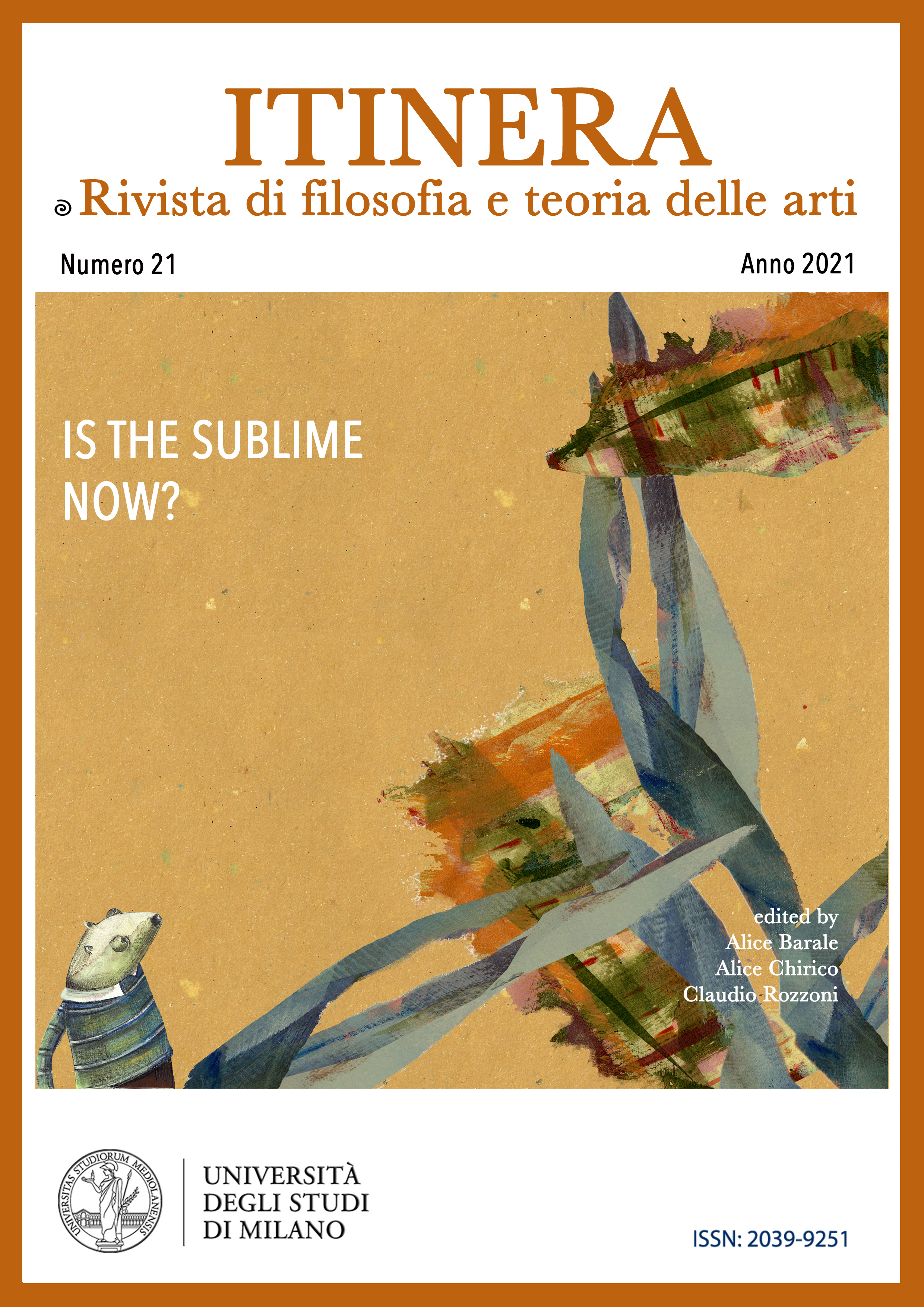«The Human Clay»: la poetica di David Hockney
Parole chiave:
David Hockney, visual education, visual perception, aestheticsAbstract
The contemporary artist David Hockney is well known as a painter of nature. However, what is the focus of his art? What is his self-appointed purpose as a painter? From a critical review of his numerous publications the answer arises naturally: humanity. David Hockney abandons abstraction and excessive naturalism, criticizes and uses photography (and other new medias) to find a way to better understand and express his humanity; to communicate his personal vision of the word. The subjects of his paintings – present or not – are humans and their peculiar way of looking, which is very different from that of a camera. Human vision takes place over time, and it carves the space. It is close to its object, and it is influenced by memory. Human beings are not only the subject but also the recipient of his work, he draws for humanity. He aims to educate himself on a more human perception and communicate it to others. Art education is visual education. Art sharpens the visual sense and makes it see the world as beautiful, thrilling and mysterious. Thus, by changing perception, it can change the world. If we look at the world more closely, if we allow ourselves to truly perceive the beauty of the ordinary, we can better love and care for our environment. This is Hockney’s duty as an artist, to paint humanity and its visual perception in order to make the world more human. In this overstimulating era of new media, he indicates to his anesthetized contemporaries a possible way to fight against their many distractions and emerging depressions and, perhaps, even to address major environmental issues.
Riferimenti bibliografici
A Day on the Grand Canal with the Emperor of China, Reg. Philip Haas, David Hockney, Milestone Films, 1988. Film.
Auden, W. H., Letters from Iceland, trad. it. A. Cilberti, Lettere dall’Islanda, Archinto, Milano 2008.
Codeluppi, V., Il potere del consumo, Bollati Boringhieri, Torino 2003.
David Hockney, 80 years in 8 works, Prod. S. Doyon, M. Kennedy, Perf. D. Hockney, Tate Britain Exhibitions, 2017 https://www.tate.org.uk/whats-on/tate-britain/exhibition/david-hockney (Consultato il 4.04.20).
David Hockney, a cura di D. Ottinger, Editions du Centre Pompidou, Parigi 2017.
Deleuze, G., Francis Bacon: Logique de la Sensation, trad. ingl. D. W. Smith, Francis Bacon: the logic of sensation, Continuum, Londra 2003.
Hockney, D., David Hockney, Thames & Hudson, Londra 1976.
Hockney, D., Gayford, M., A Bigger Message: conversations with David Hockney, Thames & Hudson, Londra 2011, trad. ingl. C. Spinoglio, A Bigger Message: conversazioni con David Hockney, Einaudi, Torino 2012.
Hockney, D., Gayford, M., A History of Pictures: From the Cave to the Computer Screen, Thames & Hudson, Londra 2016.
Hockney, D., Gross, M., No Joy at the Tate, The Observer, in http://standpointmag.co.uk/node/6781/full (consultato il 17.12.2018).
Hockney, D., Joyce, P., Hockney on Art: conversations with Paul Joyce, Little Brown, Londra 2008.
Hockney, D., Joyce, P., Hockney on Photography: conversations with Paul Joyce, Harmony Books, New York 1988.
Hockney, D., Picasso, trad. it A. Salvini, Picasso, Abscondita, Milano 2001.
Hockney, D., Secret knowledge, Thames & Hudson, Londra 2001.
Hockney, D., Secret knowledge: rediscovering the lost techniques of the old masters (New and Expanded Edition), trad. fr. P. Saint-Jean, Savoirs secrets: Les techniques perdues des maîtres anciens (Nouvelle édition augmentée), Editions Seuil, Parigi 2006.
Hockney, D., Stangos, N., That’s the Way I See It, Thames & Hudson, Londra 1993.
Hockney, D., Weschler, L., Cameraworks, Thames & Hudson, Londra 1984.
Kracauer, S., Ansichtpostkarte, trad. it. D. Pisani, Cartolina illustrata, in Strade a Berlino e altrove, Pendragon, Bologna 2004.
Kracauer, S., Kult der Zerstreuung. Über die Berliner Lichtspielhäuser; trad. it. C. Groff, Culto del divertimento, in La fabbrica del disimpegno, L'Ancora del Mediterraneo, Napoli 2002.
Lipsett, A., David Hockney condemns Ofsted report on art, in “The Guardian”, 15 Maggio 2009 https://www.theguardian.com/education/2009/may/15/hockney-boys-art (consultato il 17.12.2018).
Livingstone, M., David Hockney, Thames & Hudson, Londra 1981.
Lyotard, J.-F., Discourse, Figure, University of Minnesota Press, Minneapolis 2011.
Making a Mark: art, craft and design education, Ofsted 2008/11, Manchester 2012 https://assets.publishing.service.gov.uk/government/uploads/system/uploads/attachment_data/file/413330/Making_a_mark_-_art_craft_and_design_education_2008-11.pdf (consultato il 20.02.19).
Merleau-Ponty, M., Le monde sensible et le monde de l’expression. Cours au Collège de France. Notes, 1953, Metis Presses, Ginevra 2011.
Panofsky, E., Die Perspektive als «symbolische Form», trad. it. E. Filippini, La prospettiva come «forma simbolica», Abscondita, Milano 2013.
Rowley, G., Principles of Chinese painting, Princeton University Press, Princeton 1947.
Sayag, A., David Hockney: photographe, Herscher, Parigi 1982.
Schechner, S. J., Against the Hockney-Falco thesis: Glass and metal mirrors of the 15th century could not project undistorted images, in Technical Digest: Frontiers in Optics, 2004 https://www.researchgate.net/publication/263829764_Against_the_Hockney-Falco_thesis_Glass_and_metal_mirrors_of_the_15th_century_could_not_project_undistorted_images (consultato il 19.02.2021).
Weingarten, G., Pearls Before Breakfast: Can one of the nation’s great musicians cut through the fog of a D.C. rush hour?, The Washington Post, 2007
https://www.washingtonpost.com/lifestyle/magazine/pearls-before-breakfast-can-one-of-the-nations-great-musicians-cut-through-the-fog-of-a-dc-rush-hour-lets-find-out/2014/09/23/8a6d46da-4331-11e4-b47c-f5889e061e5f_story.html (consultato il 25.02.2019).
Dowloads
Pubblicato
Fascicolo
Sezione
Licenza
Gli autori che pubblicano su questa rivista accettano le seguenti condizioni:
1. Gli autori mantengono i diritti sulla loro opera e cedono alla rivista il diritto di prima pubblicazione dell'opera, contemporaneamente licenziata sotto una Licenza Creative Commons - Attribuzione - Condividi allo stesso modo 4.0 internazionale che permette ad altri di condividere l'opera indicando la paternità intellettuale e la prima pubblicazione su questa rivista.
2. Gli autori possono aderire ad altri accordi di licenza non esclusiva per la distribuzione della versione dell'opera pubblicata (es. depositarla in un archivio istituzionale o pubblicarla in una monografia), a patto di indicare che la prima pubblicazione è avvenuta su questa rivista.
3. Gli autori possono diffondere la loro opera online (es. in repository istituzionali o nel loro sito web) prima e durante il processo di submission, poiché può portare a scambi produttivi e aumentare le citazioni dell'opera pubblicata (Vedi The Effect of Open Access).





